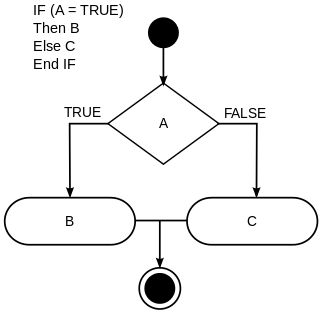
In computer programming, machine code is computer code consisting of machine language instructions, which are used to control a computer's central processing unit (CPU). For conventional binary computers, machine code is the binary representation of a computer program which is actually read and interpreted by the computer. A program in machine code consists of a sequence of machine instructions.
Pascal is an imperative and procedural programming language, designed by Niklaus Wirth as a small, efficient language intended to encourage good programming practices using structured programming and data structuring. It is named after French mathematician, philosopher and physicist Blaise Pascal.
A cross compiler is a compiler capable of creating executable code for a platform other than the one on which the compiler is running. For example, a compiler that runs on a PC but generates code that runs on Android devices is a cross compiler.

In computer science, conditionals are programming language constructs that perform different computations or actions or return different values depending on the value of a Boolean expression, called a condition.
In compiler optimization, register allocation is the process of assigning local automatic variables and expression results to a limited number of processor registers.
The Glasgow Haskell Compiler (GHC) is a native or machine code compiler for the functional programming language Haskell. It provides a cross-platform software environment for writing and testing Haskell code and supports many extensions, libraries, and optimisations that streamline the process of generating and executing code. GHC is the most commonly used Haskell compiler. It is free and open-source software released under a BSD license.

Free Pascal Compiler (FPC) is a compiler for the closely related programming-language dialects Pascal and Object Pascal. It is free software released under the GNU General Public License, with exception clauses that allow static linking against its runtime libraries and packages for any purpose in combination with any other software license.

LLVM is a set of compiler and toolchain technologies that can be used to develop a frontend for any programming language and a backend for any instruction set architecture. LLVM is designed around a language-independent intermediate representation (IR) that serves as a portable, high-level assembly language that can be optimized with a variety of transformations over multiple passes. The name LLVM originally stood for Low Level Virtual Machine, though the project has expanded and the name is no longer officially an initialism.
In computer science, a tail call is a subroutine call performed as the final action of a procedure. If the target of a tail is the same subroutine, the subroutine is said to be tail recursive, which is a special case of direct recursion. Tail recursion is particularly useful, and is often easy to optimize in implementations.
In computer science, instruction scheduling is a compiler optimization used to improve instruction-level parallelism, which improves performance on machines with instruction pipelines. Put more simply, it tries to do the following without changing the meaning of the code:
In computer science, graph transformation, or graph rewriting, concerns the technique of creating a new graph out of an original graph algorithmically. It has numerous applications, ranging from software engineering to layout algorithms and picture generation.

Scala is a strong statically typed high-level general-purpose programming language that supports both object-oriented programming and functional programming. Designed to be concise, many of Scala's design decisions are intended to address criticisms of Java.
In computer security, executable-space protection marks memory regions as non-executable, such that an attempt to execute machine code in these regions will cause an exception. It makes use of hardware features such as the NX bit, or in some cases software emulation of those features. However, technologies that emulate or supply an NX bit will usually impose a measurable overhead while using a hardware-supplied NX bit imposes no measurable overhead.
This article describes the calling conventions used when programming x86 architecture microprocessors.
Intel oneAPI DPC++/C++ Compiler and Intel C++ Compiler Classic are Intel’s C, C++, SYCL, and Data Parallel C++ (DPC++) compilers for Intel processor-based systems, available for Windows, Linux, and macOS operating systems.

GrGen.NET is a software development tool that offers programming languages that are optimized for the processing of graph structured data. The core of the languages consists of modular graph rewrite rules, which are built on declarative graph pattern matching and rewriting; they are supplemented by many of the constructs that are used in imperative and object-oriented programming, and are completed with language devices known from database query languages.
Haskell is a general-purpose, statically-typed, purely functional programming language with type inference and lazy evaluation. Designed for teaching, research, and industrial applications, Haskell has pioneered several programming language features such as type classes, which enable type-safe operator overloading, and monadic input/output (IO). It is named after logician Haskell Curry. Haskell's main implementation is the Glasgow Haskell Compiler (GHC).
The Perl virtual machine is a stack-based process virtual machine implemented as an opcodes interpreter which runs previously compiled programs written in the Perl language. The opcodes interpreter is a part of the Perl interpreter, which also contains a compiler in one executable file, commonly /usr/bin/perl on various Unix-like systems or perl.exe on Microsoft Windows systems.

Elm is a domain-specific programming language for declaratively creating web browser-based graphical user interfaces. Elm is purely functional, and is developed with emphasis on usability, performance, and robustness. It advertises "no runtime exceptions in practice", made possible by the Elm compiler's static type checking.
Idris is a purely-functional programming language with dependent types, optional lazy evaluation, and features such as a totality checker. Idris may be used as a proof assistant, but is designed to be a general-purpose programming language similar to Haskell.







